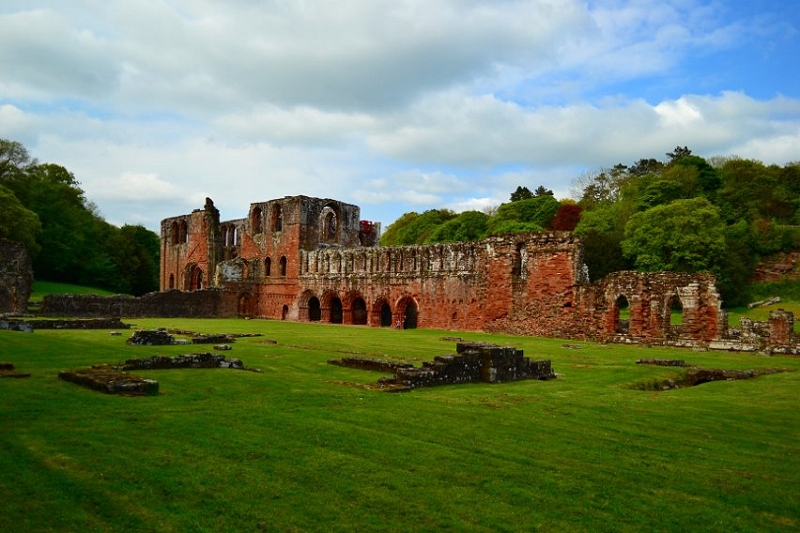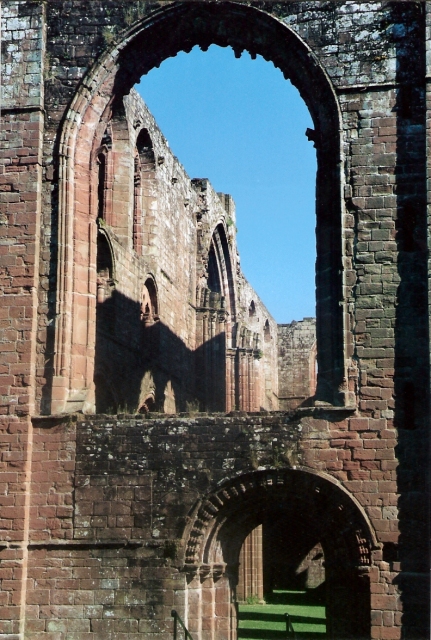
Furness Abbey lies near the southernmost tip of a peninsula which is cradled by the Atlantic Ocean on one side, and Morecambe Bay on the other. The drive south from Grasmere to Barrow-in-Furness is wondrous with sparkling waters, windmills, wide expanses of golden sands and windswept trees overlooking the vistas. Leaving the Lake District traffic behind we make good time, but still arrive only a half an hour before the 6:00PM closing time.
After seeking out the gatekeeper, who was taking a sunbath of her own in a lawn chair behind the visitors' center, and showing passes, we set out to explore this place of peace and seclusion.
Founded in 1127 as a house of the Savignac Order, the monks who lived here were commanded to merge with the Cistercian Order twenty years later. Under the Cistercian Order, the abbey steadily expanded, increasing in wealth and prosperity. The abbey possessed most of the Furness peninsula, a total of 55,000 acres of forest and rich agricultural lands. Surrounded by Morecambe Bay and the Lakeland Mountains, the abbey remained isolated until the early 14th century.
In 1322 Furness experienced a raid led by Robert the Bruce. The Abbot offered accommodation and bribes in return for immunity for the Abbey lands and dependents. The Scots accepted the hospitality and ransom money, but still sacked and pillaged the surrounding countryside and villages. An effect of this raid was the building of Piel Castle nearby and the crenellation of a number of buildings.
The development of the castle near the harbor at Piel Island improved access and trade, with the castle itself used as a fortified warehouse by the monks as a storage place for grain and wool. It was also used by the Order as a smuggling den in order to evade the high trade tariffs imposed by the King. At the Dissolution in 1536 a faction of monks encouraged the local people to rise up in protest, but by 1537 the remaining brethren were forced to give up their monastery and its possessions to the Crown.
The ruins here are extensive, set back beyond a large expanse of green lawn. We haven't long to see all there is to see and set about to make the most of the twenty minutes or so we have until closing time. There are carvings here in hidden away places; I spy some knotwork on the underside of a column. Medallions above double windows, a long corridor of towering red sandstone columns, arches on the refectory where bowls would have been placed for washing – all give off a wonderful orange-red glow in the late afternoon sunlight. A quick peek into a chamber reveals effigies worn smooth by time, a lord and his lady who remain mysteriously unnamed.
All too soon it's closing time. The woman who tends the visitors' center is very kind, a little sunburned, and most apologetic that there are no guidebooks on hand for purchase. We have a long drive ahead of us, on every color of road in the atlas. Clear, yellow, red and blue roads go whizzing by and my head nods on more than one occasion. Still, I manage to keep my eyes open, afraid that I might miss something.

Furness Abbey, or St. Mary of Furness is a former monastery located to the north of Barrow-in-Furness, Cumbria, England. The abbey dates back to 1123 and was once the second-wealthiest and most powerful Cistercian monastery in the country, behind only Fountains Abbey in North Yorkshire.
Founded in 1123 by Stephen, Count of Boulogne, it was built originally for the Order of Savigny. Located in the 'Vale of Nightshade', south of Dalton-in-Furness, the abbey is built entirely out of local sandstone. It passed in 1147 to the Cistercians, who gradually enlarged and rebuilt the original ornate church. The majority of the current ruins date from the 12th and 13th centuries.
Being about 70 miles down the coast from Scotland, the monks occasionally found themselves in between the regularly warring Scots and English. When Robert the Bruce invaded England, during The Great Raid of 1322, the abbot paid to lodge and support him, rather than risk losing the wealth and power of the abbey.
Read more about Furness Abbey at Wikipedia.